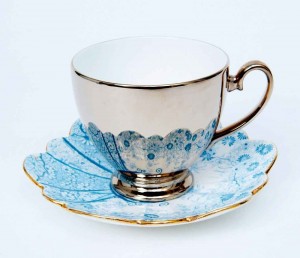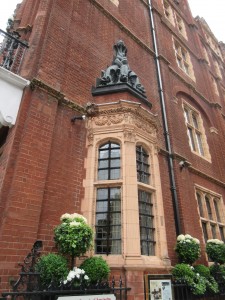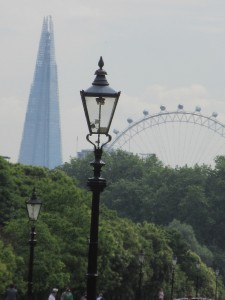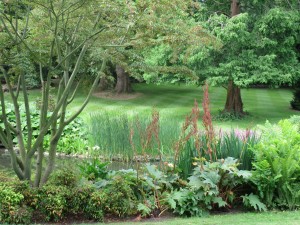 London isn’t everybody’s cup of tea
London isn’t everybody’s cup of tea
Often you hear visitors complain
Noisy, smoky city but it seems to me
There’s a magic in the fog and rain
Maybe it’s because I’m a Londoner
That I love London so
Maybe it’s because I’m a Londoner
That I think of her wherever I go
I get a funny feeling inside of me
Just walking up and down
Maybe it’s because I’m a Londoner
That I love London so.
~Written and composed by Hubert Gregg, 1947
London in July, where a heatwave lasts a whole day, peaking at 36.7C. No fog and rain here! Trains are delayed amid fears of buckling rails. The wrong kind of heat? Or perhaps because the rails are made of chocolate, as one radio presenter suggested sardonically. Passengers on the Underground are cooking. The plethora of city parks are teeming till twilight with picnickers, cyclists, joggers, dogs and toddlers. Yet despite the unusual warmth, London still dazzles.
London changed dramatically after the Great Fire of 1666. Wooden houses overhanging narrow lanes were suddenly  seen for the fire traps they undoubtedly created. Plague-ridden drains and pollution-ridden air would all be overhauled in the following centuries, ensuring cleaner water, slum clearance and efficient infrastructure. In the 19th century London’s population exploded, rocketing seven-fold to over 6.5 million, while Prince Albert, the Prince Regent and his architect, John Nash, created a new realm west of Buckingham Palace, full of quality modern housing, museums and colleges. Once rural, the arable and dairy farms of North Kensington, Nottinghill and Earls Court were sold off to developers from the mid nineteenth century. At the same time, railways spread through the city andbeyond like ivy, allowing for the creation of new middle and working class suburbs beyond the previous city boundaries.
seen for the fire traps they undoubtedly created. Plague-ridden drains and pollution-ridden air would all be overhauled in the following centuries, ensuring cleaner water, slum clearance and efficient infrastructure. In the 19th century London’s population exploded, rocketing seven-fold to over 6.5 million, while Prince Albert, the Prince Regent and his architect, John Nash, created a new realm west of Buckingham Palace, full of quality modern housing, museums and colleges. Once rural, the arable and dairy farms of North Kensington, Nottinghill and Earls Court were sold off to developers from the mid nineteenth century. At the same time, railways spread through the city andbeyond like ivy, allowing for the creation of new middle and working class suburbs beyond the previous city boundaries.
I walk everywhere: across the length and breadth of Kensington Gardens, to reintroduce myself to the Serpentine and Sir George Frampton’s bronze Peter Pan and his whispering fairies; around the splendid and stately, gleamingly golden Prince Albert whose inspiration made such a huge impact on this corner of London, beginning with his ‘crystal palace’ Grand Exhibition in Hyde Park in 1851 and ending with Queen Victoria laying the foundation stone for the Royal Albert Hall. I stroll through Hyde Park, admiring a a skyline of leafy trees, a giant ferris wheel and a sharp shard of glass scraping the sky, along wide streets lined with lush green trees and a plethora of opulent Victorian terraces. Up the mall to visit the queen and wave to the red-coated guards, resplendent in their bearskin busbies; past the deckchairs in Green Park on hire for £1.60. I watch the ubiquitous double decker buses trawl through the streets, in a never ending convoy with the traditional London taxis, no longer simply dressed in uniform, funereal black, but still distinctively shaped. I saunter along Kensington High Street to Holland Park, which is blossoming with overblown roses, squirrels and small children.
And of course, on every corner, I pass the perennial British pub. There are enough in our neighbourhood alone to make a pub crawl extremely short and messy. The Churchill Arms in Kensington is gloriously decked out in a veritable rainbow of flowering hanging baskets, while inside the ceiling seethes with hanging chamber pots. The English pub has been a tradition since the Romans wandered across the channel in about 55BC. Taverns were established for travellers to pause for refreshment – the original motorway services – and later evolved into the Anglo-Saxon alehouse, where villagers would gather to catch up on the local gossip and guzzle the local brew.
 Our current local is located in Bayswater, a mere whisper from our temporary lodgings, so we can just pop down for dinner whenever it feels too hot to cook. The Porchester is a modern take on the old English pub, with modern furnishings, eclectic seating and friendly bar staff. The ‘beer garden’ – a generous term for this tiny courtyard squeezed into a back corner of the property – is not ideal on a hot night, where the air con units blow hot air upon a handful of smokers, but inside it is cool, clean and bright. Last night the Williams sisters were dominating at Wimbledon, and if we had felt like it, we could have shared the experience with 15,000 centre court spectators by nibbling on strawberries and cream and sipping champagne in Bayswater. Instead, we opted for a platter of dips, olives, moreish sweet potato chips and a game of canasta. (Seriously bad decision. I got thrashed. Again.) The couple at the next table pulled out the Jenga blocks. A guitarist played gently in the corner. Every Tuesday, if you fancy it, there is a trivia night. It has the feel of a really relaxed, old-fashioned ‘local.’
Our current local is located in Bayswater, a mere whisper from our temporary lodgings, so we can just pop down for dinner whenever it feels too hot to cook. The Porchester is a modern take on the old English pub, with modern furnishings, eclectic seating and friendly bar staff. The ‘beer garden’ – a generous term for this tiny courtyard squeezed into a back corner of the property – is not ideal on a hot night, where the air con units blow hot air upon a handful of smokers, but inside it is cool, clean and bright. Last night the Williams sisters were dominating at Wimbledon, and if we had felt like it, we could have shared the experience with 15,000 centre court spectators by nibbling on strawberries and cream and sipping champagne in Bayswater. Instead, we opted for a platter of dips, olives, moreish sweet potato chips and a game of canasta. (Seriously bad decision. I got thrashed. Again.) The couple at the next table pulled out the Jenga blocks. A guitarist played gently in the corner. Every Tuesday, if you fancy it, there is a trivia night. It has the feel of a really relaxed, old-fashioned ‘local.’
Had we been in the mood on this record-breaking summer day, the menu was full of hale and hearty English pub food with modern culinary nomenclature: fish and chips became ‘Haddock fillet in Young’s ale batter served with minted pea puree, hand cut chips and tartar sauce,’ or there was a ‘British braised lamb shepherd’s pie,’ ‘Cumberland sausages with mash, ale gravy and caramelized onions’ or ‘gnocchi with wild mushrooms, brie and white wine sauce, shaved parmesan, rocket and truffle oil.’ The Porchester boasts that all their produce is fresh, seasonal and locally sourced and there is a good selection of boutique beers with temptingly poetic names.
Fed and watered, we decide to stretch our legs and wander through the streets of Bayswater and Westbourne Park in the fading light. Twenty five years ago Queensway shops reflected its largely central Asian population. Today, it is full of Middle Eastern restaurants, shisha cafes and souvenir shops. And up over the railway line, past Royal Oak Tube Station, under the overpass, and down a narrow street, we discover the Regents Canal, a short cul-de-sac canal that runs through the northern suburbs from Paddington Basin to the Grand Union Canal that links Birmingham and London. Now lined with beautiful old barges and canal boats, some converted into coffee stops, we join the locals who have escaped their overheated houses to stroll along the cool canal path with eager dogs, or settled on park benches with jugs of beer.
fading light. Twenty five years ago Queensway shops reflected its largely central Asian population. Today, it is full of Middle Eastern restaurants, shisha cafes and souvenir shops. And up over the railway line, past Royal Oak Tube Station, under the overpass, and down a narrow street, we discover the Regents Canal, a short cul-de-sac canal that runs through the northern suburbs from Paddington Basin to the Grand Union Canal that links Birmingham and London. Now lined with beautiful old barges and canal boats, some converted into coffee stops, we join the locals who have escaped their overheated houses to stroll along the cool canal path with eager dogs, or settled on park benches with jugs of beer.
London in the summer is a sheer delight: lushly green, boasting acres of park lands, gardens, rivers and ponds; unexpected architectural surprises around every corner; literally endless options for eating, drinking and entertainment. I am in seventh heaven. Expensive yes, often over-crowded, very occasionally over-heated, it nonetheless hums and thrives with good will and eccentric bus drivers. I am addicted.
*All my own photos apart from Richard Brendon’s beautiful cup and scalloped saucer care of Google Images.
